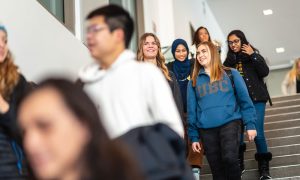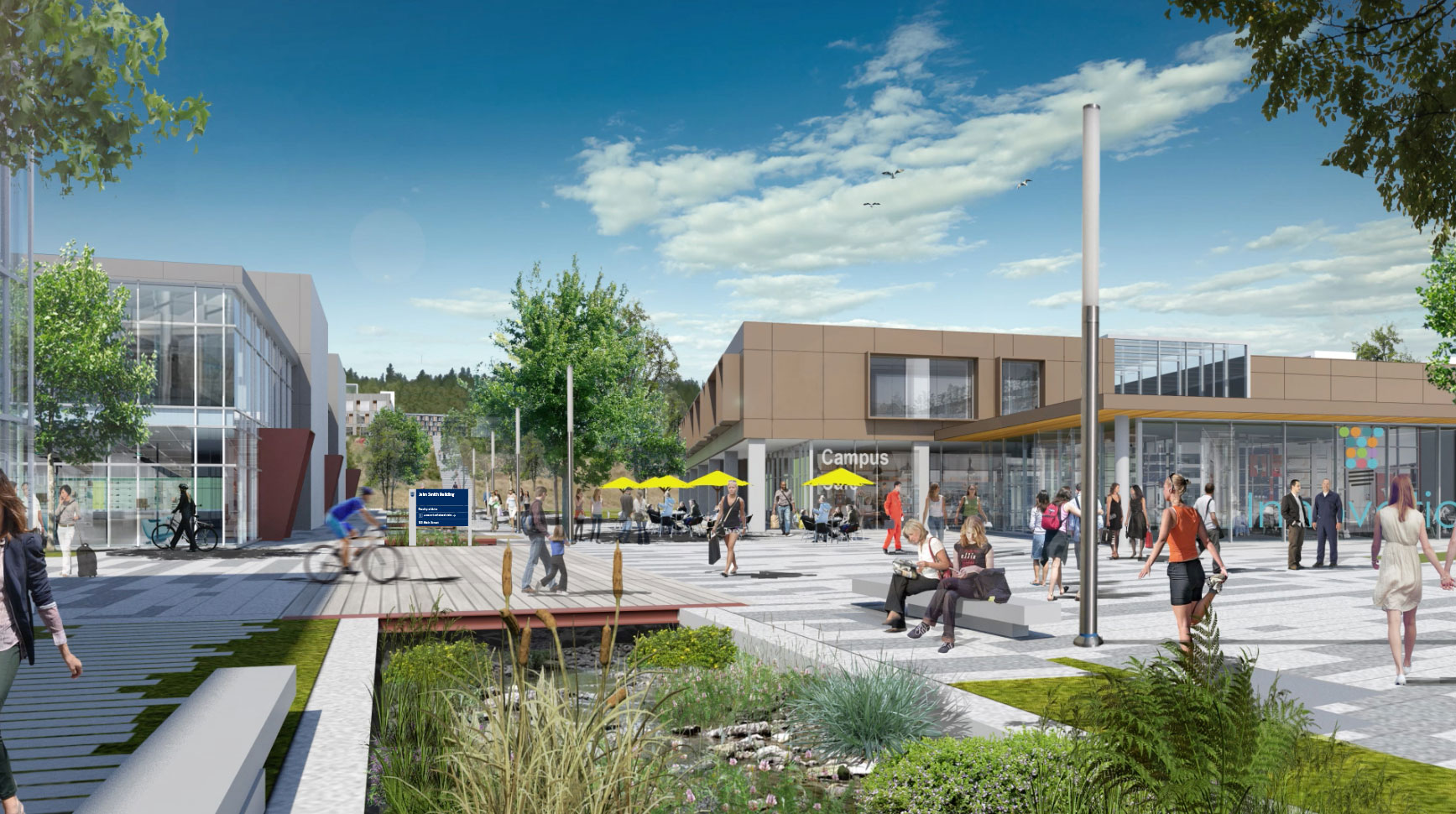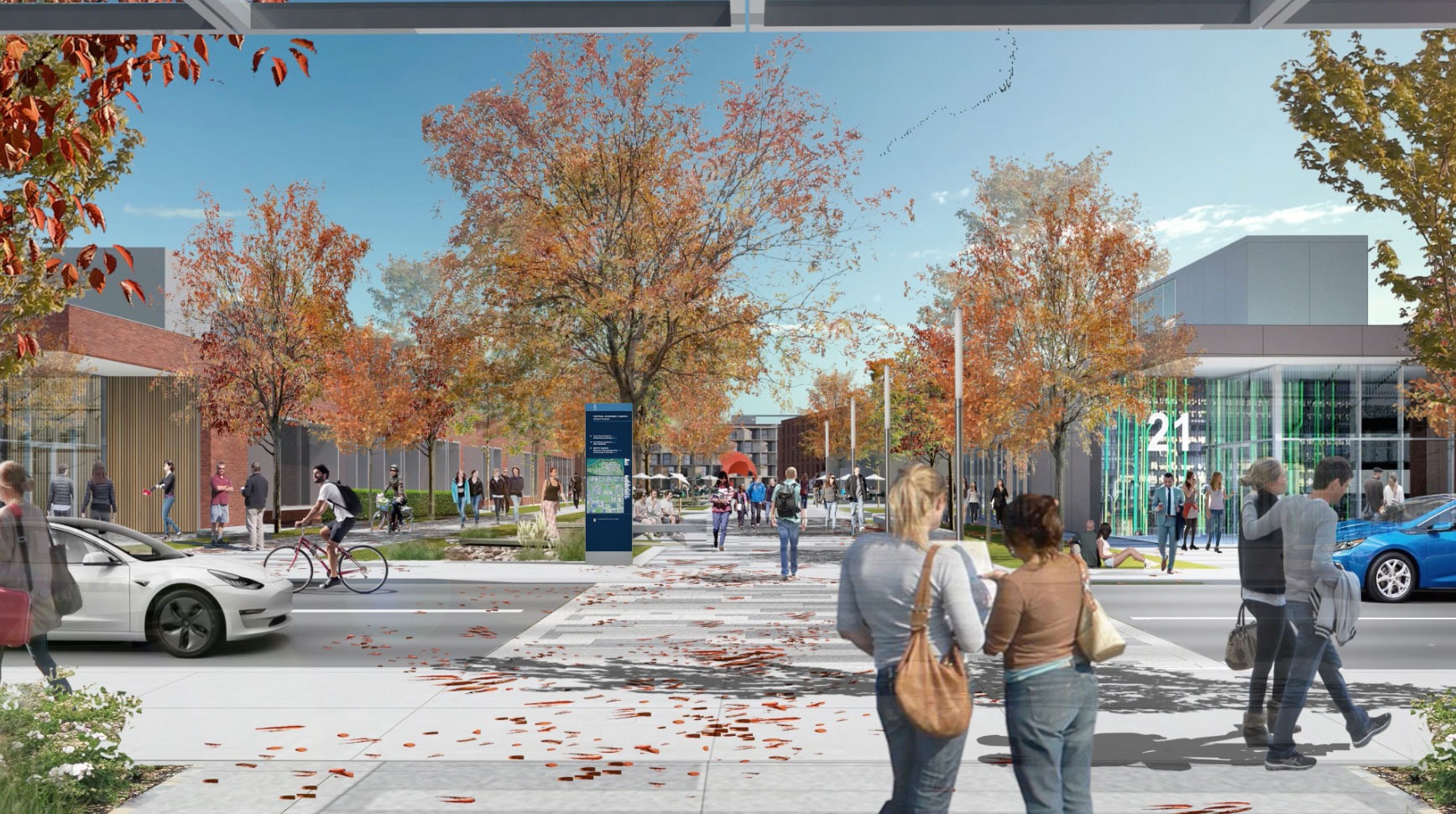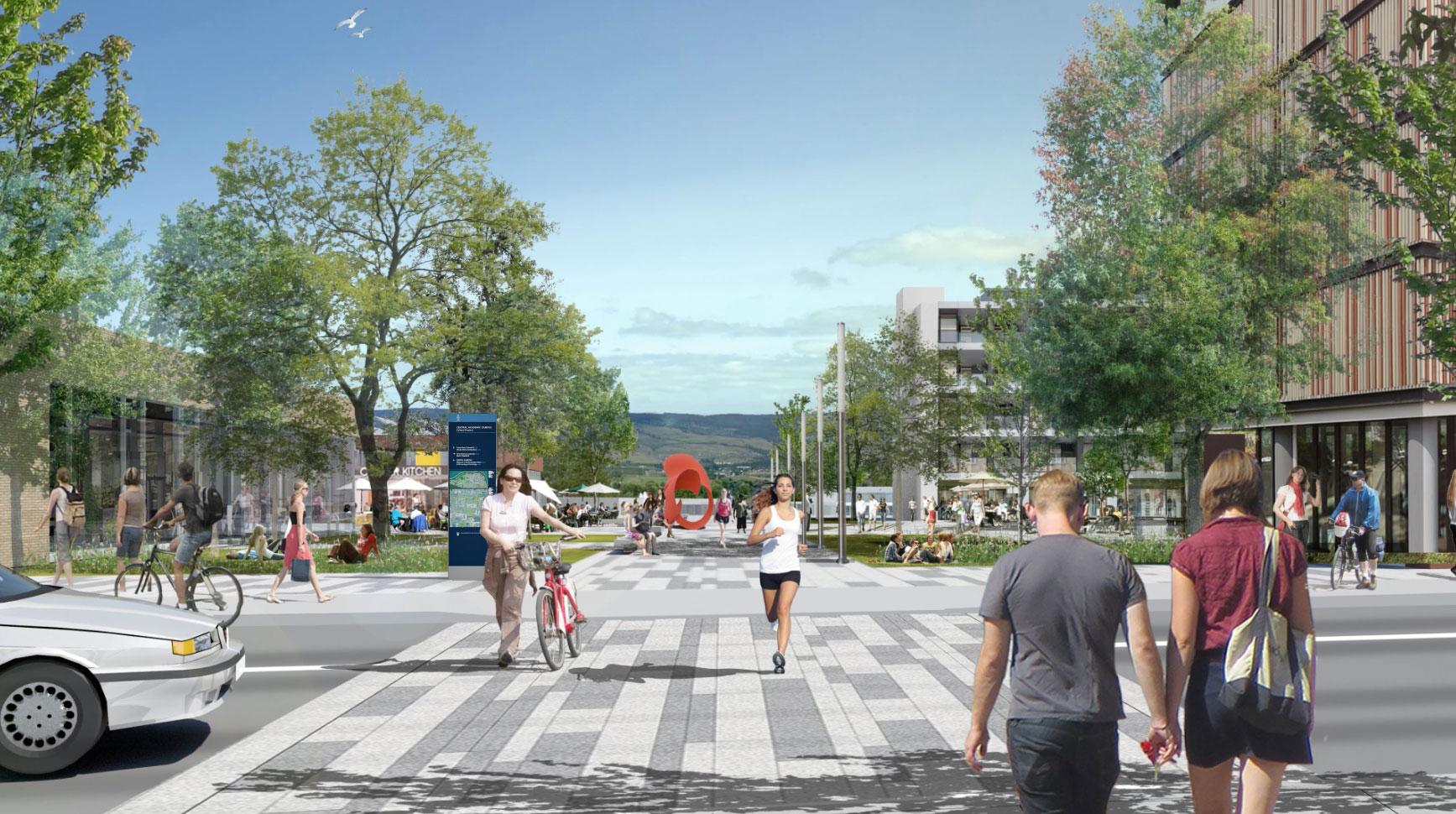December 23, 2019
WE ARE LIVING IN A TIME OF UNPRECEDENTED TRANSFORMATION, driven forward by advances that, just 50 years ago, were virtually unimaginable. From smartphones and electric vehicles to quantum computing and gene editing technology, our world is undergoing cultural, scientific, and geographical change at an exponential rate.
No surprise, then, that universities the world over are also experiencing a seismic shift, as they adjust to a changing landscape of students, research, and industry. Institutions of higher learning and their leadership are undergoing a period of soul searching, as they seek to understand their role over the coming decades.
In Kelowna, however, the university of the future is already taking shape. In 14 short years, UBC Okanagan has gone from a small satellite campus of 3,500 students to a thriving, research-driven campus of almost 11,000. And it’s charting a path to the future with an ambitious visioning document, Outlook 2040, that imagines UBCO two decades from today.
The report describes an invigorating place of learning, where thousands of students and researchers from around the globe work together to address local challenges and issues of global importance. Its purpose-built laboratories are powered by the latest in cutting-edge technologies, and its activities play an integral role in the economic and cultural growth of the region.
While most institutional forecasts tend to look five to ten years out, Outlook 2040 took a different approach to its scope and vision.
While most institutional forecasts tend to look five to 10 years out, Outlook 2040 took a different approach to its scope and vision. Remarkably, it was pulled together in just five months, sparked by a challenge from UBC’s Board of Governors in September 2018. The request: that UBCO’s leadership envision the campus 20 years into the future, with a roadmap describing the needs and resources required to get there.
For Deborah Buszard, Deputy Vice-Chancellor and Principal of UBCO, the scale of such a sweeping exercise was, not surprisingly, a little overwhelming.
“When the board said, ‘Tell us where you’re going in the next 20 years, and tell us what you need to get to where you aspire to be’, I will be honest and say that my first thought was, ‘20 years, that’s out there,’” she admits, with a laugh.
But Deborah soon embraced the challenge. “We plan for enrolment, we plan for budget, we plan for new buildings. We all have medium and short-term plans — and now we had a chance to think about connecting that to the longer term.”
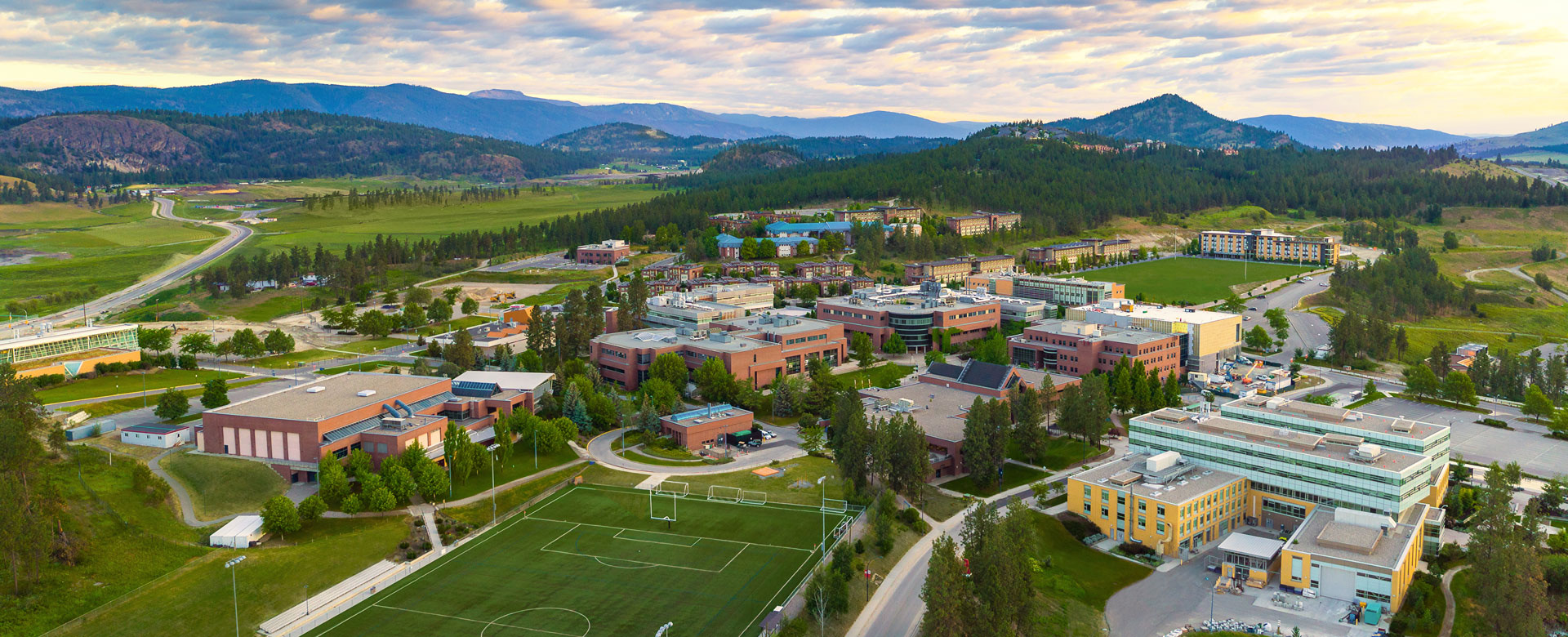
UBC’s Okanagan campus today.
Collective visioning
It’s one thing to ask for a 20-year visioning document, but in the face of ever-increasing technological and digital advance, where, on earth, do you even start? That question fell to Nicole Udzenija, Director of Strategic Initiatives in the Office of the Deputy Vice-Chancellor and Principal, UBC Okanagan, who convened a team to develop the scope of the visioning initiative that would become Outlook 2040.
The answer, she says, was to look to UBC’s overarching 10-year strategic plan, Shaping UBC’s Next Century, released in 2018 — as well as UBCO’s 2014 Aspire plan, a foundational document outlining the key guiding principles for the campus into its second decade and beyond.
“Whatever we wanted to envision had to be grounded in the now and who UBC is,” Nicole says. With the strategic pillars of UBC’s overarching vision in mind, the next step was to begin looking at forecasting trends — without getting too caught in the weeds.
“Often, when you embark on visioning or forecasting you can get bound up in what’s possible or impossible now,” she says. “The mandate of 20 years into the future was kind of a gift, really, because that takes you out of the tyranny of the now, and allows you to think a bit more boldly. Looking 20 years out, you can look at a bunch of trend data and forecasting, but at the same time, you can start to dream a little bigger.”
Dreaming big
With economic, population, research, academic, and education trends in hand, UBCO did, indeed dream big. Working groups gathered input from the faculties and the Okanagan Senate, as well as from members of the campus’ external community advisory council — which includes the mayors of five municipalities, as well as leaders in business, health and medicine, and the university’s Indigenous partners in the Okanagan Nation.
Outlook 2040 delivers a vision of a globally connected campus filled with a rich diversity of students, deep community engagement in the region, and first-class research facilities. In 20 years’ time, UBCO anticipates it will be home to up to 20,000 students — a quarter of them international, with annual research funds of $100 million. (Contrast that to 2005, when it opened its doors to just 3,500 students, with research funds of $5 million.)
BY 2040, UBCO WILL…
Be a thriving community of over 20,000, including 18,000 students and 500 faculty.
Be a leader in Canada in the proportion of Indigenous faculty and students.
Have established endowments that will bring funding per student and financial support on par with UBC Vancouver.
Have $100 million+ per year in research funding, up from $21.9 million in 2017/18.
Have an additional 1 million square feet of space.
Have an annual economic impact in the Okanagan region of $4.8 billion, up from $1.5 billion today.
A new 50-acre Innovation Precinct, currently in development, will play a large role in driving forward UBCO as a research-led institution that responds to the current and future needs of society at the regional and global level.
Phil Barker, Vice-Principal of Research and Innovation at UBCO and Associate Vice-President of Research for UBC, explains: “The purpose of the Innovation Precinct is to act as a collision zone between UBC researchers and outside organizations. It will be a research and development hub that allows UBC researchers to contribute to solving pressing issues with non-profit and for-profit entities — and at the same time, provide us with some interesting academic challenges.”
Unlike long-established post-secondary institutions with storied histories, UBCO is in a position to actively respond to society’s needs and global trends practically in real time, says Phil. “When you’re an institution which has been doing this for a long time, you can get embedded in a way of thinking, and surrounded by a set of infrastructure constraints that make it difficult to pivot quickly. This is much more of a green field project. With the Innovation Precinct, we can cast a future in multiple directions, in a way that most campuses can’t.”
The university of the future will be powered by more than research, notes Bryce Traister, Dean of the Faculty of Creative and Critical Studies for UBCO, who helped shape Outlook 2040 as part of the Dean’s working group.
“At no point was there ever any intention that the Okanagan campus in 2040 was going to be a campus of specialized professional schools,” he stresses. “The vision of 2040 that is very exciting for people who work in the arts, social sciences and humanities is that it absolutely understands the broad education of the mind that takes place within the liberal arts, at the undergraduate and graduate level, to be central to the articulation of the vision.”
A commitment to interdisciplinary learning is threaded throughout Outlook 2040, and, as Bryce points out, “this includes expectations for significant capital investment in new buildings, and the growth of the professoriate on campus as well as the growth of the graduate cohort.” The influence of Outlook 2040 is already being felt in the development of three new programs within Bryce’s faculty, which include world literature, communications, and a newly emerging field of medical humanities.
“None of these things were really remotely conceivable until the Outlook 2040 document came into view and was endorsed by the board of governors,” notes Bryce. “It would be difficult to imagine actually bringing them online until it was clear to me that there was a long-term vision for the campus to embrace and to sustain the development of new programs like this. It gives us a foundation upon which to build.”
Transformative force
Ananya Mukherjee Reed, UBCO Provost and Vice-President, Academic, UBC Okanagan, also stresses the role of UBCO as a driver and contributor to the broader local and global community. “UBCO will be an institution that never closes its doors to anyone who wants to learn, at any stage of one’s life,” she says. “This is critical at a time when knowledge is evolving so rapidly. Universities must ensure that people are served by the advances in knowledge, and not excluded or displaced by them. This means not only that we must rethink our pedagogy, our degree structures and our research practices, but also engage the public in this process of rethinking.”
For Rehan Sadiq, Executive Associate Dean of the School of Engineering at UBCO, the emphasis on problem-focused, interdisciplinary research is particularly exciting. “From my perspective of engineering and working with other faculties, I hope to see more problem-focused research,” he says.
“I would like to see our school focusing on some core interdisciplinary issues which really matter to society — for example, anything around the clean tech sector, having a future hub for materials and manufacturing, green construction, integrated water management, aerospace engineering, and digital health and biomedical engineering, etc. There are some very key issues which are specific to this place, and I would like to see our school be recognized in future for that kind of expertise and training.”

Students studying in The Commons building.
Ananya adds: “Toni Morrison once said: ‘If there is a book that you want to read, but it hasn’t been written yet, you must be the one to write it.’ This is true about creating institutions as well. There is a lot of thinking, and re-thinking, going on about universities and their contribution to society. I hope to see UBC as a leader in these discussions.”
One need only look at how far UBCO has come in the 14 years since it was founded to realize just how much transformative power is contained within its walls. Deborah, who has been with UBCO since 2012, says that’s precisely what initially drew her to the campus.
“I’m absolutely taken with the impact that universities have on society and on the communities that they are in and that they serve,” she says.
“This university being in a start-up mode was a very interesting opportunity to think about, what it would mean to grow a great institution into something like a McGill or a Cornell or an MIT from scratch.”
Deborah points to the Okanagan’s tremendous economic growth as an indication of how UBCO has — and will continue to — contribute to the investment and prosperity in what was once a region known primarily for agriculture and tourism.
“This region now has some of the fastest growing municipalities in Canada,” she says, noting that the Kelowna airport is now the tenth busiest airport in the country, with international flights and cross-Canada flights. “UBCO has helped transform Kelowna from what it was 20 years ago. We are one of the largest employers in the region. We provide healthcare professionals, from physicians and psychologists, to nurses and social workers. We just launched a new advanced manufacturing program, and our next engineering program will be aerospace.”
To hear Deborah tell it, UBCO’s effect on the region has been transformational and, as Outlook 2040 predicts, it will continue. According to Nicole, the Kelowna region is on-side for the ride. “Our surrounding community has been very supportive and excited by the bigger picture we painted with Outlook 2040,” she says. She stresses the deepening partnership with the Okanagan Nation, and its critical role in helping lead the campus into the future.
Indigenous partnership

sn̓ilíʔtn, a permanent installation by Syilx artist Les Louis in UBCO’s central courtyard.
“We were founded in partnership with the Okanagan Nation Alliance, and that continues to be very formative for us and a major piece in the plan going forward. We plan to be a national leader with respect to Indigenization,” she says.
“The Okanagan Nation chiefs have consistently demonstrated great support for and interest in the success of this campus, and see it as a really tremendous resource for their community members going forward,” adds Deborah, pointing to UBCO’s Aboriginal Access Studies Program as an indication of the university’s commitment to its partnership with its Indigenous community neighbours. “We admit every Indigenous student who applies. We say, ‘If you apply and if you demonstrate that you’re actually interested in coming to UBC, we will give you cultural, social and academic support in an access program.’”
That intention is reflected in Outlook 2040, underlined by a commitment to develop implementation plans to meet the Truth and Reconciliation Commission’s Calls to Action. Those goals are listed alongside UBCO’s plans to expand learning and research space, increase the number of its graduate students, develop its innovation precinct, and strengthen its efforts to recruit top faculty and staff — all underlined and embedded in UBC’s overarching strategic plan.
“I find it a combination of both inspirational and specific, which I think is great,” says Blye Frank, Dean of UBC’s Faculty of Education which, in July 2018, merged the university’s two Faculties of Education in Vancouver and Kelowna, and created a new Okanagan School of Education. “When you’ve got a document which produces a vision for the move forward, which has some specificity to it but which is also inspirational, I think you get some grip. I think it’s closely aligned with UBC’ s strategic plan, which demonstrates that alignment between the two campuses.”
“We were founded in partnership with the Okanagan Nation Alliance, and that continues to be very formative for us and a major piece of the thinking in the plan going forward. We plan to be a national leader with respect to Indigenization.”
In addition to his role as Dean of the Faculty of Education, since June 2019 Blye has also chaired a new bi-campus Task Force on Cross-Campus Collaboration, made up of senior leadership from both campuses. “What we’re finding is that some of the things that people always named as challenges or barriers to cross-collaboration are not, in fact, barriers at all. We’re finding ways to strategize to bring about stronger collaboration, particularly around teaching and the transfer of students, and in making programs on each campus available to all UBC. So, Outlook 2040 opens up a number of those possibilities.”
Taken as a whole, Outlook 2040 offers an unapologetically ambitious goal of leading UBCO from its start-up phase to a fully-fledged, internationally renowned research campus, responsive to the most pressing needs of our modern world. It’s a vision that has been warmly welcomed since its release, says Nicole.
“We have got it out to various groups and had extremely positive reactions to it,” she recalls. “When we presented it to our Okanagan Senate, they gave it a standing ovation. It was daunting when we got the charge to do this, but it fostered some really great conversations here and some really great thinking. And it has given us a picture of a future that we can all feel invigorated about. It gives us the foundation to say, ‘Well, if that’s the moon, let’s start laying out the steps to get there.’”
